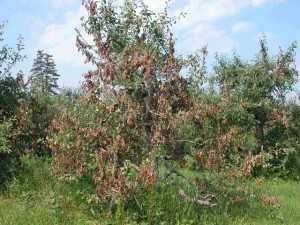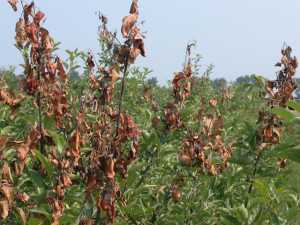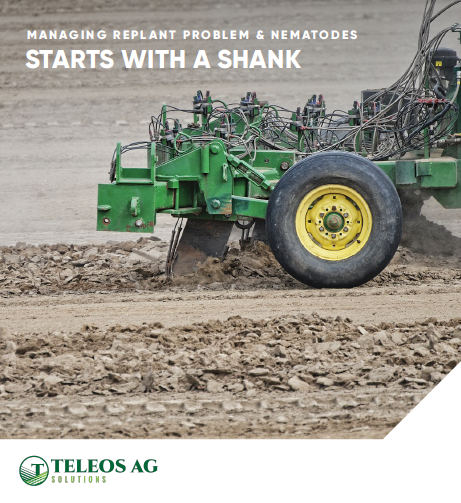Promising Alternatives To Antibiotic Fire Blight Control

Research has begun in Michigan to take the best alternative practices from the West and study how those can be used as fire blight controls in the East and Midwest. (Photo credit: George Sundin, MSU)
Fire blight can be a devastating bacterial disease to apple and pear trees, no matter what region. For years, organic pear and apple growers have relied on oxytetracycline and streptomycin — two effective antibiotics — to protect their orchards. As of Oct. 21, 2014, both will no longer be options for them.
The phase-out of antibiotic use in organic orchards has been anticipated by growers and researchers for quite some time, and researchers throughout the country have been investigating organic options to provide growers with answers before a complete loss of oxytetracycline and streptomycin.
Here is a round-up of promising research underway to provide organic growers with alternatives to antibiotics.
California, Oregon, Washington
Out West, the research team of Ken Johnson of Oregon State University, Tim Smith of Washington State University, and Rachel Elkins from University of California Cooperative Extension have been investigating the use of a yeast product as well as some copper applications, and other existing materials. Seeing how they work in combination, and which order of use is best, is part of the strategy.
Smith notes this research on alternatives to antibiotics has been ongoing for a dozen years or more as new products and options became available for testing. The Washington Tree Fruit Research Commission and companies have helped to support seeking out effective alternatives. Johnson’s three-state research project is funded by a USDA Organic Research and Education Initiative (OREI).
More Consistent Than Oxytetracycline
For Western growers, applications of Blossom Protect, a yeast product from Europe, has proven to be very successful in Johnson and Smith’s research when following a lime sulfur spray to reduce crop load.
“This product has worked better than and more consistently than the oxytetracycline over the years that we’ve been testing it. The only time it didn’t work well was when we didn’t follow the directions on the label,” he says.
In their research, Smith says he and Johnson’s trials included testing different rates and applications of the yest and the associated buffer did not improve performance. He notes there has been some concern about russetting with Blossom Protect, but he has not seen it in his research.
“It turns out they’ve done good, diligent, science in Europe where they developed it. We couldn’t improve on their suggestions,” he says.
Smith recommends following directions and using the buffer that comes with the product. The buffer includes some nutrients that feed the yeast.

Removing fire blight from an orchard can result in a significant loss of trees. (Photo credit: Ken Johnson, OSU)
Copper Applications
Another option to combat fire blight is copper. However, the traditional copper products cannot be used once bloom begins because of the risk of russet, which can make a crop unacceptable for the fresh fruit market. New products with a lower metallic-copper concentrations, such as Cueva and Previsto, are being tested during and after bloom and so far show reduced, but not zero, risk of russet. Johnson says the end goal of this project is devise integrated programs that prevent fire blight and do not cause russetting.
This year, Smith says the research team is testing Serenade Optimum more intensively with different spray rates in different sequences. So far, he says, it has been performing on the level with oxytetracycline. There are also some materials that Smith can’t yet discuss.
A big component of the research is preventing a build-up of fire blight bacteria on the flower. Smith says that once the population gets to a dangerous level, growers have few options to stave off a fire blight infection.
“The research we’re doing this year is more in sequential treatments with multiple materials rather than just trying to come up with the big hammer. [We’re] trying to look at ways to suppress the population from building in the first place.” Smith says.
Johnson says he believes fire blight can be controlled without antibiotics, with some risks. But, as the demand for organic tree fruit keeps growing, those risks may be worth it.
“The programs will be somewhat more expensive, and will slightly increase the risk of a poor finish (russetting) of the fruit. But the majority of growers [will stay in organic production], after they understand the programs will be successful,” Johnson says. “Some growers in the wrong climate or with the wrong cultivar might have to switch back to conventional, but if there is a strong market (as there is this year), it is likely that losses in organic production will be filled by someone else.”
A Three-Year Project In Michigan
Research has begun in Michigan on applying some of what has worked out West to the conditions in Michigan, thanks to a $464,000 grant from USDA. George Sundin, a professor in the Plant, Soil, and Microbial Sciences Department at Michigan State University and Matthew Grieshop, an associate professor in MSU’s Organic Pest Management lab will be working on the project.
“Organics are growing in the Midwest and Eastern U.S., but [growers are] very limited by diseases — fire blight and apple scab being the main ones. It all has to do with our environment and our humid conditions,” Sundin says. “We’ve tested many different controls for fire blight over the past 12, 13 years with very little success in the East. Same materials they use [in the West], same kinds of experiments done. But, ours never seem to work or they might work one year but not the next.”

Fire blight can be a devastating bacteria for apple and pear growers. In October, organic growers will lose two effective antibiotic controls. Researchers across the country have been developing alternative fire blight control programs. (Photo credit: George Sundin, MSU)
He says the lack of consistent results, along with the phase-out of antibiotics this fall, led Sundin and Grieshop to seek out how to apply what has worked in the West to Michigan.
“The grant was really borne out of our desire to understand how these organisms control fire blight and how they’re affected in our environment, in our region,” he says.
In The First Year Of Research
This is the first year of the project, and Sundin says the research will focus on Blossom Protect, a yeast spray that has had success out West. Sundin hopes to study how the yeast works with the humid conditions. The research will also involve sterilizing the flower with Oxidate prior to the Blossom Protect application with the hopes of giving the yeast a higher success rate. There is thought that the organisms occurring naturally on the apple flowers could inhibit the colonization of the yeast. Sundin will also examine how the yeast colonizes the different parts of the flower.
Sundin and Grieshop are working with highly-susceptible varieties — Jonathan and Gala — with the intention of finding the best results with where the fire blight bacteria will be the most damaging. Sundin is curious to see what influence apple cultivars have in the process of fire blight prevention.
The research team is also examining what type of phytotoxicity that copper applications will have on the fruit, and on the severity of russetting could develop. Sundin notes that there are several formulations with lower amounts of copper and those have shown less russetting in the West. Along with studying the phytotoxicity of the copper, he plans to see what type of application rates are needed in order to maintain control.
Michigan’s more-humid climate can cause copper applications to dry slowly, says Sundin. The copper stays on the fruit surface longer, and increases the risk of russetting.
“That’s another issue that’s unique to our environment that we may have to deal with, but the copper may be safe enough that we can get the activity, and disease control out of it and be safe from phytotoxicity,” he says.
Research will also examine what type of compatibility that biocontrols such as Blossom Protect and Serenade Optimum have with copper application. Sundin notes that many of these fire blight control options have not been tested together.
Looking To The Future Of The Research
After a few years, Sundin says research will be moved on to orchards for application.
As for now, organic apple growers in Michigan will have to rely on what Sundin and Grieshop discover this year for the 2015 growing season.
“By the end of this year, when the antibiotics are phased out, we’re going to be basically relying — from my standpoint — on what we see this year to make some suggestions for next year. Growers may have to implement these and hope that they are going to work while we’re still tinkering and trying to optimize them,” Sundin says.
Putting The Information In One Place
David Granatstein, sustainable agriculture specialist with Washington State University in Wenatchee, WA, and Harold Ostenson, organic tree fruit consultant, partnered with The Organic Center to provide organic apple and pear growers with information on non-antibiotic options in one place via the publication they wrote titled “Grower Lessons and Emerging Research for Developing an Integrated Non-Antibiotic Fire Blight Control Program in Organic Fruit”
This resource incorporates practices growers may already be doing along with the research out of the western states and the OREI project on alternatives. Granatstein says the publication, (see “Online Resources For Organic Growers”), is meant to be a confidence-builder for organic growers as they face the loss of antibiotics. Final recommendations from formal research are not yet available, but enough has been learned that growers need to start testing alternatives in their orchards now.
“Given the demand for organic apples and pears still going up, we didn’t want to see a huge wash-out of folks producing those crops,” Granatstein says. “The prices are great, the demand is there. So if non-antibiotic fire blight control is the stumbling block, what can we do to help prevent a big exit from organic apple and pear production?”
Granatstein says that as he and Ostenson approached the creation of a resource for growers, Ostenson stressed the need to incorporate different considerations, products, and sequences.
“He felt that you can’t put this information out there in isolation. In the spring people aren’t just trying to control fire blight and fire blight alone. They have a lot of other issues they’re dealing with,” Granatstein says.
Ostenson stressed that many of the products or practices growers use to prevent or combat fire blight also useful to address other issues in the orchard.
“That’s the good news. It’s not all just additive. There may be a lot of complimentary to the control,” Granatstein says.
Although the loss of antibiotics is a blow to organic growers, Granatstein says that there are options and resources for growers to use other non-antibiotic controls for fire blight.
Granatstein points to a presentation from Ken Johnson (see “Online Resources For Organic Growers”) outlining a possible program for an alternative to antibiotics. Johnson’s presentation, as well as the document he put together with Ostenson provide growers with a lot of information an and number of options to try.
“That was our whole goal, to get information out there — even though much of it is preliminary — to induce growers to go out and try these alternatives, see what works in their orchard and build their confidence because they need to make a change,” he says.
Online Resources For Organic Growers
There are several options for organic tree fruit growers to read up on and get informed for the 2015 growing season.
- Ostenson and Granatstein’s “Grower Lessons and Emerging Research for Developing an Integrated Non-Antibiotic Fire Blight Control Program in Organic Fruit” is found here.
- Maryblyt, a fire blight predictive model is found here.
- A comprehensive webinar from Johnson, Smith, and Elkins on their research is found here.
- George Sundin has extensive videos on tree fruit growing — some conventional — on Michigan State University’s Tree Fruit Pathology YouTube channel.
- Resources for organic growers from Washington State University can be found here.
- Ken Johnson’s presentation on alternatives to antibiotics is found here.
Antibiotic Alternatives
Here is a list of some of the products available to growers as an alternative fire blight control.
- Blossom Protect, from Westbridge, contains microorganisms which block the fire blight pathogen from colonizing the blossoms and nectaries through natural competition for space and nutrients. Westbridge.com/110
- Serenade Optimum, from Bayer, is a fungicide and bactericide that stops harmful spores from germinating, disrupts the cell membrane growth, and inhibits attachment of the pathogen to the leaf. BayerCropScience.us/products/fungicides/serenade-optimum
- CS 2005, from Magna Bon, is copper sulfate pentahydrate, acidic, liquid pesticide and is an USEPA registered bactericide fungicide. MagnaBon.com/cs-2005
- Cueva, from Certis, is a fixed copper fungicide using low concentrations of copper and decomposes to soluble copper and fatty acid. CertisUSA.com
- Previsto, from Gowan, is a fixed copper fungicide that is pending registration. GowanCo.com
- Bloomtime, from Verdesian Life Sciences, is a naturally-occurring biological that suppresses fire blight in apples and pears. NuFarm will distribute in 2015. VLSci.com
- BlightBan, from NuFarm, uses a beneficial bacterium for the suppression or control of fire blight. NuFarm.com/USAg










